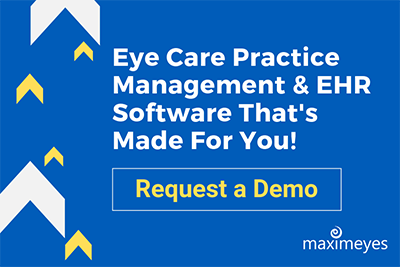
08 Jul Patient Portals Move Patient Care Forward for Eye Care Practices
Patient portals have been around for years. However, during the COVID-19 pandemic, many eye care providers realize how important this technology is to move patient care forward in an ever-increasing digital healthcare and telehealth and telemedicine environment.
A patient portal that integrates with your ophthalmology and optometry EHR provides the most options for engaging your patients, increasing patient satisfaction, and reducing patient care costs. EHR patient portals bring the benefits of cloud-based communication to your practice, so interactions—from bill pay to viewing treatment plans—occur in a secure online environment.
If you want to remain competitive and keep up with the younger generation, it’s important to offer more straightforward ways to interact with your patients 24/7. While more older patients are using electronic devices to communicate with their doctors, many still don’t see the benefits of using a patient portal to access health information, schedule appointments, communicate with their doctor, and pay medical bills.
Here are some benefits to using patient portal tools with your optometric EHR, and how you can encourage patients to take an active role in their healthcare and see a spike in patient engagement.
Benefits of Using Advanced Patient Portal Tools With Your Optometric EHR
Communicate with patients via secure emails. Send and receive HIPAA-compliant electronic messages, medical treatment plans, ophthalmic test results, contact lens and spectacle prescriptions, and healthcare educational materials. MaximEyes EHR’s patient portal has built-in education documents that you can customize and quickly link to a patient’s encounter.
Easier and time-saving scheduling. Now more than ever, many patients want the flexibility of scheduling appointments online. Save an average of two to four minutes per patient and spend less time on the phone booking appointments.
Convenient online bill pay 24/7. Paying online is becoming more popular as people want the freedom to pay bills at home or on mobile devices. Every practice wants to get paid faster and decrease time by hunting down payments, mailing out invoices, collecting funds over the phone, and manually posting payments. Reduce past-due balances, eliminate data entry errors, improve cash flow, and get paid faster with text and email reminders right from your patient portal.
Be proactive with patient care. Patient portals offer a seamless workflow and interoperability with your EHR, and they are an excellent way to connect with patients and deliver on-demand, secure access to protected health information (PHI) from recent doctor visits. The patient check-in and check-out processes are faster, and the patient’s visit will be more efficient.
Speed up the check-in process with online welcome/medical history forms. To maintain a healthy business and prevent workplace exposure to COVID-19, patients can use an EHR patient portal where they can review and update their medical history data before they visit your office from the comfort of their own home.
Reduce transcription errors with automatic EHR syncs. Manually entering patient health information can escalate into mistakes that negatively impact your patient’s care. Mistakes cause confusion and reflect poorly on the professionalism of your practice. Eliminate rekeying data into your EHR and save time with automatic syncs for scheduling, billing, demographics, and health history data.
How to Get Patients to Use the Patient Portal

Getting patients to sign up and use the patient portal system is the number one hurdle to patient engagement. In a Health Affairs journal study, the top two reasons patients don’t use a portal are they prefer to speak directly with the provider and they don’t see the benefits of using the patient portal.
How do you encourage patients to register on the patient portal and keep them coming back? The key is to make their first experience pleasant, so they continue to use their patient portal. Here are a few tips to get you started.
Promote and advertise your patient portal
- Add a colorful and visible button on your website (on all web pages) that links to your secure patient portal.
- Add a message on your phone voicemail menus and on-hold voice messages.
- Hang laminated posters or flyers in the waiting room, exam room, and restrooms.
- Have staff wear an “Ask me about our secure patient portal” button to encourage questions.
- Add the patient portal URL to appointment cards, patient education materials, invoices, business cards, and letterhead.
- Create an eye-catching graphic for social media posts. Canva is an excellent tool for creating stunning visual assets. Choose from professionally designed templates for a variety of content platforms, and thousands of royalty-free icons, photos, and fonts.
- Create a simple postcard or flyer to give patients that includes your patient portal URL and instructions on how to sign up. Include a place on the form where patients can write down their username and password.
Educate and involve your staff, including other providers
- Train your staff and other providers so they can learn the patient portal inside and out.
- Write an elevator pitch (a short description of critical benefits) that your staff can verbally share with patients during their office visit or when the patient calls into the office.
- Make the patient portal registration part of the check-in and check-out process. Make sure you collect email addresses or confirm that the email has changed. Walk patients through the login process before they leave the office.
- Remind patients they can schedule appointments online through their patient portal.
- Remind patients they can view their medical history, eye exam results, clinical summaries, and educational materials online.
Encourage and incentivize patients to use their portal
- Encourage patients to send your office a secure message from their patient portal. Once they sign up, enter them into a drawing for a prize or gift card.
- Export email addresses from your optometric practice management and EHR system for patients who have not enrolled in your patient portal. Send a series of emails to these patients encouraging them to choose a username and password. Enter them into a monthly drawing.
- Use the patient portal to send messages and announcements, such as appointment reminders, health tips, practice news, local events, special promotions, office closures, and COVID-19 safety. Always include a link to the patient portal to engage patients and initiate interactions.
- Send targeted health information to specific patients, such as diabetes and dry eye management.
- Require all patients to email your practice only through their patient portal.
- Offer patients a discount on their next optical purchase if they sign up for the patient portal while in your office.
- Offer patients a discount off their bill if they pay their bills via their patient portal.
- Enter the patient’s name into a monthly drawing if the patient schedules an appointment online.
Billing Tips for Patient Portal Telehealth E-Visits
While the percentage of optometrists providing telehealth and telemedicine services is decreasing now that practices are reopening and providing routine eye care, it’s still critical to prepare now should the need arise. A Jobson Optical Research report shows that 65% of optometry practices plan to continue offering some telehealth and telemedicine services.
Use your HIPAA-compliant patient portal for secure telehealth e-visits (asynchronous store-and-forward visits) when no live interaction is needed for an established patient. You can bill for the limited e-visit services using 99421–99423. Informed consent is required from the patient before you begin the visit, and you must document the consent in the patient’s electronic health record.
To help make the transition to billing and coding for telehealth and telemedicine services more manageable, we’ve put together a free Telehealth and Telemedicine Billing Guide for Eye Care Professionals During COVID-19.
Managing the Patient-Provider Relationship with Optometric EHR and Practice Management Systems
When properly optimized, ophthalmology and optometry EHR and practice management systems drive strategic decisions and quality improvements, enhance patient care, and deliver long-term value-added benefits to your practice. It’s important to continually explore, evolve, and embrace new optometric EHR technologies that improve and streamline office efficiency.
Need help increasing patient portal engagement? Request a demo to see how MaximEyes EHR and its advanced patient portal tools offer the support you need.

If you are a current MaximEyes customer, email sales@first-insight.com or call 800.920.1940, ext. 6659 for more information on how you can add the EyeClinic.net advanced patient portal tools to your MaximEyes EHR system. The advanced patient portal tools are coming soon to MaximEyes.com.




